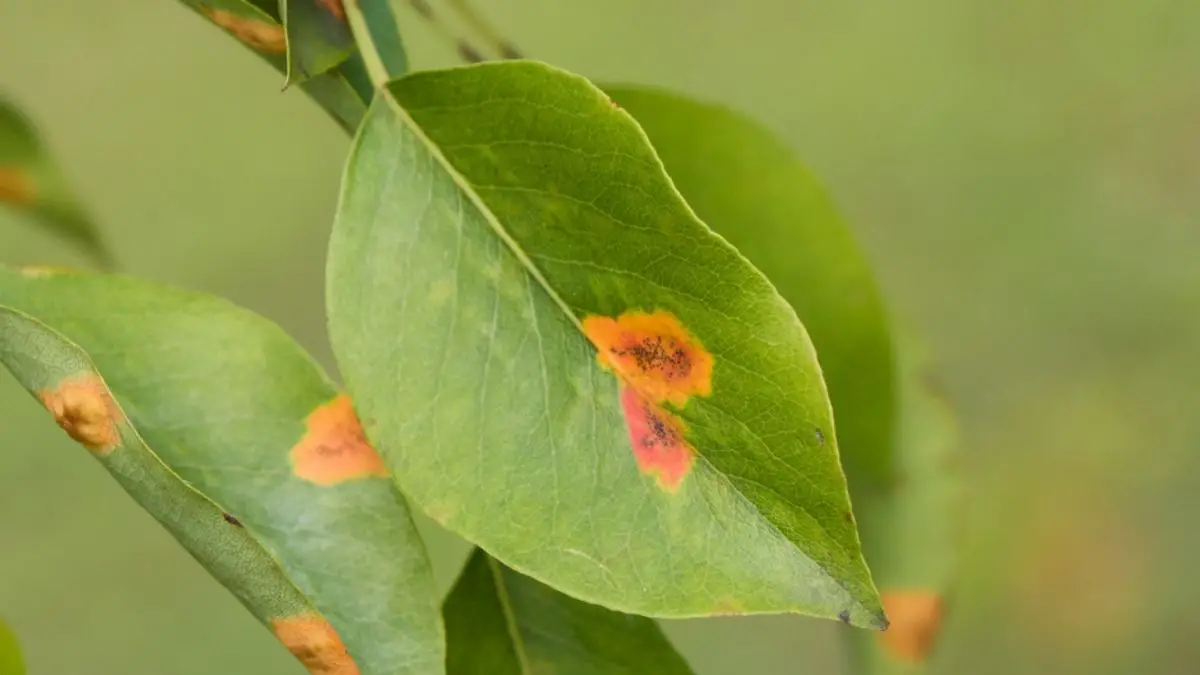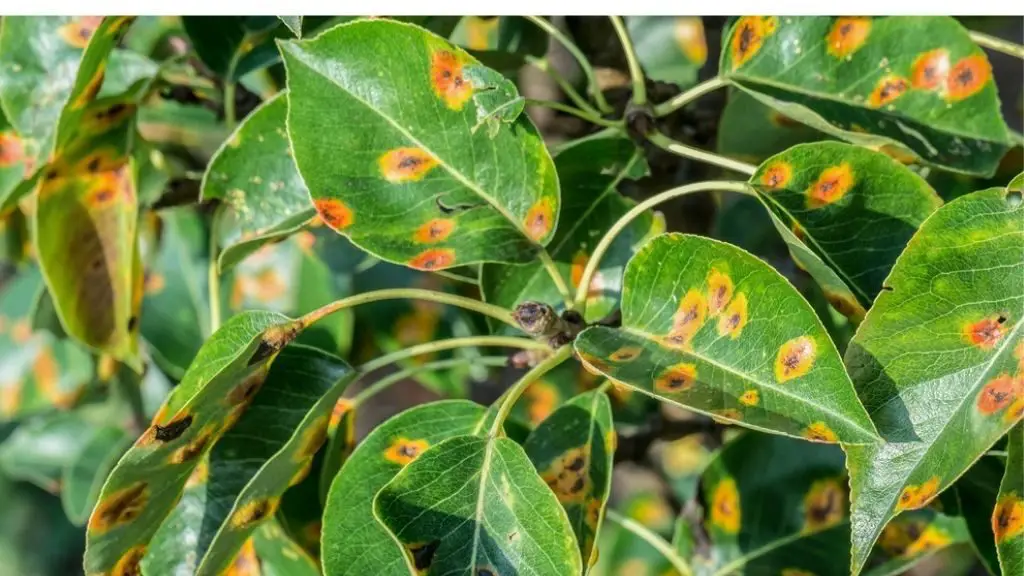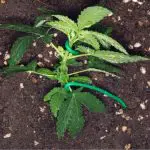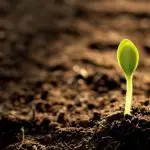Rust Spots on Leaves during Flowering: Know Why these Occur

Are you observing the emergence of Rust spots on leaves during flowering? Then this must be a sign that your plants are in trouble. So, what exactly is this trouble and what measures you should take. Here, we are discussing this in detail.
As the population is growing it is getting hard to feed everyone We simply don’t get enough yield to fulfill everyone’s desire. On top of that, different diseases and pathogens attack the plants and destroy them. One of them is Rust.
Stay with us till the end as we explain everything about Rust spots and what happens if they appear during the flowering stage.
Rust Spots on leaves during Flowering: What are they?
Rusts are a group of fungal diseases that can cause a decline in plants. There are approximately 5000 species of rusts that are associated with plants in some way. Phragmidium is the most common rust species that harm plants.
Mostly, leaves are affected in this but spots can also be found on stems. The rust generally emerges during the flowering stage which is highly undesirable as flowering is then affected and the grower will end up with a low yield. Plants like tomatoes, roses, beans, snapdragons, daylilies, pines, etc are considered highly prone to rust attack. Initially, white spots start to raise on the underside of the leaves. Then after some time, these white spots turn orange. Leaves will start turning yellow and may also die due to this.
Rust spots appear when Calcium or magnesium is deficient. Generally, it is the magnesium deficiency that caused such spots to appear. But that’s not the only reason. Later, we are discussing different major reasons for the emergence of Rust Spots on leaves during Flowering. But now, let’s check out which spots you should consider and which spots you should ignore.
If you see one or two spots on a plant, then these are not the cause of worry. However, if you start to see a lot of them, then it is time to do something (which we are describing later). But how do you know these spots are due to Rust? Rust spots are generally surface-level spots and can become dry and crumbly with time. They may even pinch a hole in between the leaf. The identification of rust stops is not difficult, but determining the reason for their emergence is an arduous task.
Your real test comes when you look at the rust spots during flowering and that you don’t know why these spots are appearing. Now, let’s see different reasons why these spots may occur.
Rust spots in the middle of leaves during flowering: What are the reasons?
Want to know What causes rust spots on leaves? Then this section is for you. Here we are discussing what causes rust spots on plants in detail. Without pondering over the causes, there is nothing you can do to mitigate their harmful effects. But we are not stopping there. After that, we will be discussing how to treat rust disease on plants in detail!
Possible reasons why rust spots appear during the flowering stage are:
Pests- the most feared Factor among Growers
Pest is the common reason outdoors for the Rust attack on leaves. Indoor plants are still not safe from pest attacks. Aphid is the common pest to causes rust spots to occur. If you are observing leaves getting brown spots, then look for the little devils aka aphids. It also causes tiny punctures in the middle of the leaf. They move from plant to plant and reproduce in large numbers. So, if you see even a small number of Aphids, start the treatment immediately.
Calcium and Magnesium Deficiency
If the rusty spots are due to nutrition deficiency, then the situation will get worse as the flowering progresses. Generally, it is the deficiency of Calcium and magnesium that causes rust spots to appear on the leaves. Although both are nutrients, they exhibit different symptoms.
Magnesium deficiency is different than Calcium deficiency but the symptom of brown spot emergence is the same. Let’s discuss magnesium deficiency first as it is more common than Calcium deficiency.
In Magnesium deficiency, when the spots spread, leaves start to curl up and turn yellow. But how do you recognize it is due to magnesium deficiency? Look for the following things to know whether magnesium deficiency is there or not:
- Brown spots first appear on the older leaves if Magnesium deficiency is there.
- Discolouring between the veins of old leaves occur.
- The edge of the leaves will start to curl up and the stem of the plant will start turning purple.
On the other hand, symptoms of calcium deficiency first appear on the new/younger leaves. The brown spots start to form at the edges first and then move towards the center of the leaves.
Whichever nutrient is deficient, the emergence of Rust spots on leaves during flowering is a phenomenon you have to deal with immediately.
Nutrient Lockout
Sometimes, plants face the condition of Nutrient lockout. In this, plant roots are unable to uptake nutrients due to some reasons. The most common one is undesirable soil pH. In this condition, even if you add chemical fertilizers, your plants will not be able to uptake nutrients.
A nutrient lockout can cause nutrient deficiency. So, make sure that your plant is not facing it as even the treatment of any nutrient deficiency won’t do any good. It generally happens when soil pH is not optimum. Another reason is if the water stays longer in the soil.
To confirm it is Nutrient lockout, we recommend you do a soil test. if you find out the pH of the soil is high or low than the optimum number, then surely there is a nutrient lockout.
Nute Burn
Not only nutrient deficiency, but nutrient excess can also cause rusty spots to appear. Excess of nutrients also knows as Nute Burn, can lead to copper spots on leaves, and even then your plants will have no idea what to do with all that excessive nutrients.
You will observe yellowing leaves with brown spots during flowering in a Nute burn. The spots first start to appear in lower leaves and then the condition spread upwards. First, the leaf turns yellow, then brown, and then eventually dies off due to excess of nutrients.
Cannabis growers commonly observe Rust spots on Autoflower leaves. This is because Autoflowers are sensitive to any undesirable surroundings and can’t really handle any attack. Autoflower growers make the stupid mistake to add more nutrients in the form of fertilizers to make the plant look lush green. This causes Nute Burn and leaves start to get affected.
Fungus Attack
If you see brown spots, then the chances of fungi attack are high. If you are growing plants in high humidity, then the chances get even higher.
We all know that fungi love moisture. So, take good care of moisture percentage when dealing with any plant.

Now, the most important Part: The Treatment.
Rust spots on leaves treatment (The Ultimate Guide)
It’s a shame that rusty spots appear on dark green leaves during flowering. If you observe any of these spots, start the treatment without any delay. But how to get rid of rust on plant leaves? To answer this, it is now time to discuss rust spots on leaves treatment or cure.
Following are the things you must do when you spot rust:
- Remove/Dispose of the affected leaves as they may spread the disease to other plants. If the plant is badly affected, then it is better to completely remove this plant to protect the nearby ones.
- Use a fungicide to control the spread of the fungus. Apply copper sprays and sulfur powders for better results.
- Use soap solutions or neem oil to get rid of insects like aphids.
- Add fertilizers to curb the problem of calcium and Magnesium deficiency. But, don’t add them in large quantities as Nutrient Burn is another cause of rusty spots. So, add chemical fertilizers smartly and timely. Moreover, use organic fertilizers as well because they release nutrients slowly. Ths slow release doesn’t allow Nute Burn to happen.
Preventive measures
Have you heard the common Proverb,” Prevention is better than cure”? The reason we asked is that this proverb is 100 percent true. If you follow these preventive measures, there won’t even come a time where you have to apply any treatment.
- If you are growing plants indoors, then have a proper ventilation system. Moreover, control the humidity as much as you can.
- Grow Rust-resistant varieties as you won’t face any rust problems after that.
- Don’t over-water your plants unnecessarily. The water around the root for a longer period of time invites different types of fungus. However, if the plant is facing Nute burn condition, then overwatering is the only way out. This overwatering is called Flushing and is done with balanced pH water. Moreover, water in the early morning for better results.
- Maintain a proper plant to plant and row to row distance. If you don’t, then chances of insect-pest and fungus spread are more. So, do smart gardening and grow the plants according to the recommendations by experts.
Final Words
To sum up, there are several reasons for the emergence of Rust spots on leaves during flowering. These include Pest attack, fungus, nutrient deficiency, and nutrient burn. If you observe the rusty spots in the middle of the leaves, then immediately start preparing for the treatment we have described in this Article. If you don’t do anything, then your plant will have stunted growth and will produce low yields. So, don’t take the rust spots lightly and do what smart a gardener does- Taking care of every plant.
What are your views regarding this Article? Do tell us in the Comment Section down below!
FAQs about the Emergence of Rust spots on leaves during Flowering
How do you treat rust spots on leaves?
There are many treatments you can opt for to treat rust spots. But first, you have to identify what is the reason for these spots. If the reason is pests, then apply insecticides. If the reason is a fungus, then apply fungicide and control the humidity level. If the reason is nutrient deficiency, then apply the nutrients. If the reason is Nute burn, then flushing is the best thing you can do. These are all the treatments of Rust spots on leaves during the Flowering stage.
How do you get rid of rust fungus?
By first identifying the cause and applying the treatment, you can get rid of rust fungus. By identifying the cause we mean why the fungus spread in the first place. You must be doing over-watering, have high humidity around plants, or not disposing of the already affected ones. Then, start the treatment which is mostly fungicide-based. Moreover, apply copper and sulfur solutions to further curb the fungus spread.
Should I remove yellow leaves during flowering?
Yes, you should remove yellow leaves during the flowering. When the leaves start to turn yellow, then plants apply their energy to get them back to life. This energy should have been used for flowering. As the plants spend this energy on leaf restoration, flowering is affected. So, avoid this from happening, remove the yellow leaves.
How do you treat Cal Mag deficiency?
Calcium and Magnesium deficiency is another reason for rusty spots. To get rid of this deficiency, chemical fertilizers are recommended as they release the nutrients fast. You can also add organic fertilizers but they release nutrients slowly. However, keep the quantity in mind while applying the fertilizers as Nute burn can also negatively impact the plants.
Related Topics:








